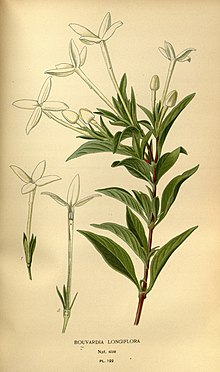| Bouvardia longiflora | |
|---|---|

| |
| Scientific classification | |
| Kingdom: | Plantae |
| Clade: | Tracheophytes |
| Clade: | Angiosperms |
| Clade: | Eudicots |
| Clade: | Asterids |
| Order: | Gentianales |
| Family: | Rubiaceae |
| Genus: | Bouvardia |
| Species: | B. longiflora |
| Binomial name | |
| Bouvardia longiflora (Cav.) Kunth | |
| Synonyms | |
|
Aeginetia longiflora Cav., 1801 | |
Bouvardia longiflora, commonly known as the scented bouvardia, is a species of flowering plant in the family Rubiaceae. It is first described by Spanish botanist Antonio José Cavanilles in 1801 from a specimen in the collection of Luis Née. The holotype specimen is from a location between Querétaro and Guanajuato.
The most commonly cultivated member of the genus, it is grown for its scent. It grows in sheltered spots in the garden with good drainage. The scent is most prominent in the evenings. They can withstand a winter minimum of 50 F.
References
- Blackwell, Will H. Jr. (1968). "Revision of Bouvardia (Rubiaceae)". Annals of the Missouri Botanical Garden. 55 (1): 1–30 . doi:10.2307/2394817. JSTOR 2394817.
- Forsythe, Holly Kerr (2007). The Constant Gardener. The Miegunyah Press. p. 339. ISBN 978-0-522-85432-9.
- Loewer, H. Peter (1999). Fragrant Gardens: How to Select and Make the Most of Scented Flowers and Leaves. Houghton Mifflin Harcourt. p. 104. ISBN 978-0-395-88492-8.
| Taxon identifiers | |
|---|---|
| Bouvardia longiflora | |
This Rubioideae-related article is a stub. You can help Misplaced Pages by expanding it. |